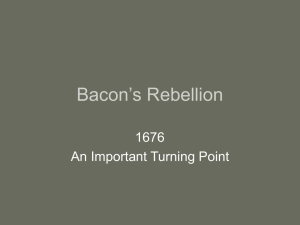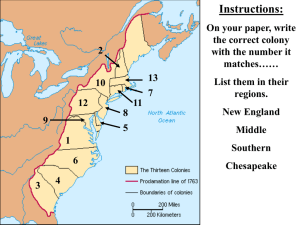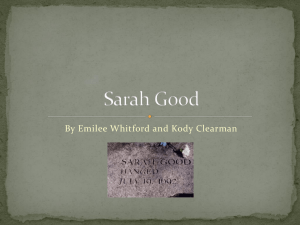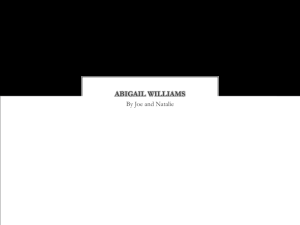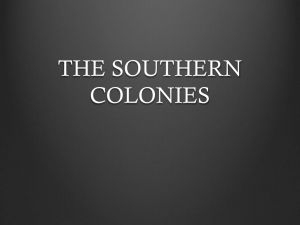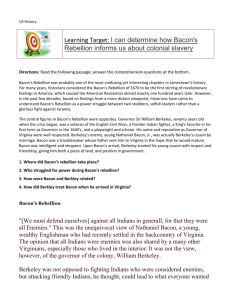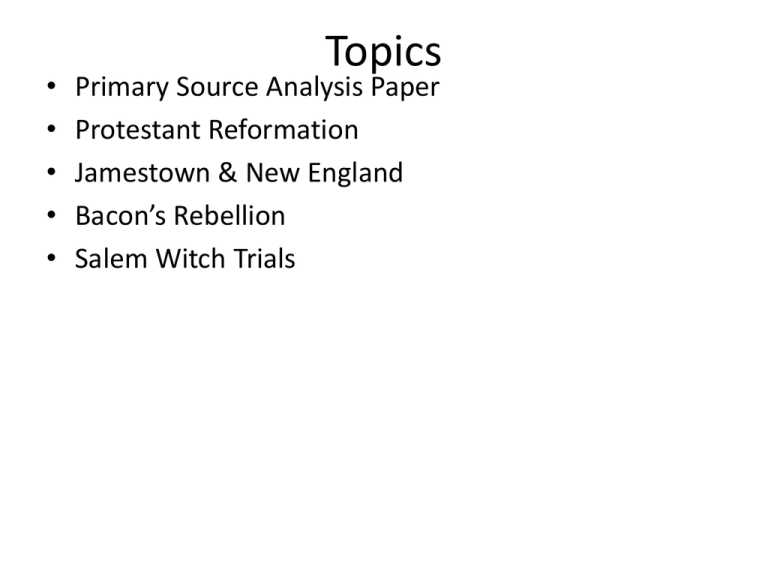
•
•
•
•
•
Topics
Primary Source Analysis Paper
Protestant Reformation
Jamestown & New England
Bacon’s Rebellion
Salem Witch Trials
Rubric for Short Answer Responses
25 Points
5 Points
Length 2.5
Organization 2.5
15 Points
Answered the questions
5 Points
Grammar 2.5
writing clarity 2.5
New Amsterdam
– 1614, Dutch build fort to trade with Native
Americans for furs
– 1625, Dutch found New Amsterdam on
Manhattan Island
Jamestown Colonization Pattern:
1620-1660
Tobacco Prices 1618-1710
New England & Chesapeake
Differences
New England
Economy lumbering, shipbuilding, fur trading, rum-distilling
people are more likely to live in towns, tightly clustered
Emigrated as families
No separation of Church and State
Established schools: Harvard 1636
Highly literate society, more than 50% of men literate
New England & Chesapeake
Differences
Chesapeake Bay
Economy tobacco
Settlements large farms more spread out
High death rate
Anglican Church established; all support by taxes
Less religious than New England
Bacon’s Rebellion 1675-1676
• Bacon’s Rebellion 1675-1676
• Class of big planters and indentured servants, which form a
landless class: social mobility difficult for indentured servants
• Jamestown is burned and plantations are looted
• 1st Social Rebellion in British North America
Nathaniel Bacon
Nathaniel Bacon
Nathaniel Bacon came to Virginia as a
gentleman in the 1670s, but his
resentment of the economic and political
domination of the colony by a small
group of planters transformed him into a
backwoods rebel. In 1676, Bacon led an
army of discontented farmers, servants,
and slaves against the powerful coastal
planters--and almost won. In this stained
glass window, discovered and restored in
the twentieth century, Bacon's social
class and his commanding presence are
both evident. (The Association for the
Preservation of Virginia Antiquities at
Bacon's Castle, Library of Virginia)
Copyright © Houghton Mifflin Company. All rights reserved.
Tobacco Prices 1618-1710
Eastern
North
America,
1650
Numerous European
towns and settlements
dotted the Atlantic
coastline by mid-century,
while Indian populations
disappeared or dispersed
toward the interior of the
continent.
Copyright (c) Cengage Learning. All Rights Reserved.
New England 1614-1625
Dissenters
Roger Williams 1635 is banned; establishes Rhode Island &
separation of Church and State.(1647)
Anne Hutchinson 1637 challenged religious authorities,
expelled from New England
Relations with Native Americans (Pequots)
little missionary work: Praying towns
Great Migration 1610-1668 relations worsened
King Philip’s War 1675-1676
Metacom (King Philip) united Native Americans against
English: killed 600 colonists
Ended native resistance to English expansion in New England
Salem Witch Trials 1691-1693
1690s Inequality grows in New England
Salem: Salem Town and Salem Village, rivalry
Begin in 1692 when Tituba is accused of witchcraft by Betty
Parris and Abigail
Over 300 people were accused: 19 hanged
1693 the governor ends the trials
Accused witches over 40 yrs
Accusers (women in their late teens and early 20s)
The problem was rooted in economic differences.
Salem Witch Trials 1691-1693
1690s Inequality grows in New England
Salem: Salem Town and Salem Village, rivalry
1692, Tituba, East African Slave, fortune teller, first accused of
practicing witchcraft
Hysteria spreads
Over 300 people were accused: 19 hanged
1693 the governor ends the trials
The problem was rooted in economic differences: the accused
witches tended to be wealthier than the accusers
Middle Colonies
• 1624 New Amsterdam; fur trade, 1664 English
• 1637 New Sweden; fur, 1655 Dutch, 1664
English
• Pennsylvania 1681, William Penn
– Society of Friends
– Diverse: Welch, Irish, Scottish, German,
Scandinavians
• Pluralism: No official church
Lower South
Carolinas (1729)
• 1670 South Carolina settled by English from
West Indies, Barbados
• Rice was the cash crop; large plantations
• Slave conditions worse than in Chesapeake
– Isolated and closely supervised
• 1710s blacks outnumbered whites
• Stono Rebellion 1739 implemented a harsh
slave code
Lower South
Georgia 1732
• Georgia named after King George II.
• Group of trustees: James Oglethorpe
– Haven for debtors
– Vision of a society of small farmers (500 acres)
– Slavery and alcohol banned
• 1750 vision falls apart: slavery is legal
• Buffer between South Carolina and Spanish
Florida
•
•
•
•
•
Lower South
Carolinas (1729)
Georgia
1670 South Carolina settled by English from
West Indies
Rice was the cash crop; large plantations
1710s blacks outnumbered whites
Stono Rebellion 1739 implemented a harsh
slave code
1732 Georgia; buffer between South Carolina
and Spanish Florida; debtors a fresh start




